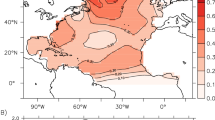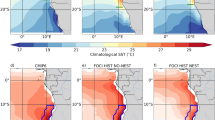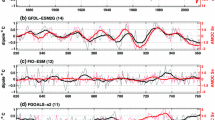Abstract
Through its control on the marine ITCZ, future changes in the tropical Atlantic meridional sea-surface temperature gradient (TAG) could have important impacts, on regional to global scales. We study the inter-model spread of projected TAG trends in response to increasing CO2, using results from 19 coupled GCMs which took part in the IPCC fourth assessment. Some models project substantial changes, with the smallest changes being in boreal autumn. There is substantial uncertainty, with no consistency even in the sign of change, and an ensemble mean close to zero. However, a strong statistical relationship is found between the simulated magnitudes of TAG trends and unforced TAG variability. Models with larger unforced variability in December–February show larger magnitude trends. We speculate that this relationship may be due to an underlying system of feedbacks whose strength varies considerably from model to model (the unforced variability ranges by a factor of 3 amongst these models, and the models exhibit large differences in mean state). We present evidence from further analysis and the literature to suggest which physical mechanisms may be involved. In particular, models projecting larger(smaller) magnitude TAG trends have larger(smaller) SST variability and cooler(warmer) mean SST in not just the Atlantic, but all three tropical/sub-tropical oceans, especially in the southern hemisphere near eastern coasts. These results could assist efforts to understand model errors in present and future tropical climate, and to develop observational constraints on future tropical projections.






Similar content being viewed by others
References
Barreiro M, Giannini A, Chang P, Saravanan R (2004) On the role of the South Atlantic atmospheric circulation in tropical Atlantic variability. Earth’s climate: the ocean–atmosphere interaction. Geophys. Monogr., vol 147. American Geophysical Union, pp 121–142
Biasutti M, Battisti DS, Sarachik ES (2005) Terrestrial influence on the annual cycle of the Atlantic ITCZ in an AGCM coupled to a slab ocean model. J Clim 18(1):211–228. doi:10.1175/JCLI3262.1
Breugem WP, Hazeleger W, Haarsma RJ (2006) Multimodel study of tropical Atlantic variability and change. Geophys Res Lett 33(23):L23706. doi:10.1029/2006GL027831
Breugem WP, Hazeleger W, Haarsma RJ (2007) Mechanisms of northern tropical Atlantic variability and response to CO2 doubling. J Clim (in press)
Chang P, Ji L, Li H (1997) A decadal climate variation in the tropical Atlantic Ocean from thermodynamic air–sea interactions. Nature 385(6616):516–518. doi:10.1038/385516a0
Chang P, Yamagata T, Schopf P et al (2006) Climate fluctuations of tropical coupled systems—the role of ocean dynamics. J Clim 19(20):5122–5174. doi:10.1175/JCLI3903.1
Chiang JCH, Sobel AH (2002) Tropical tropospheric temperature variations caused by ENSO and their influence on the remote tropical climate. J Clim 15(18):2616–2631. doi:10.1175/1520-0442(2002)015<2616:TTTVCB>2.0.CO;2
Chiang JCH, Vimont DJ (2004) Analogous Pacific and Atlantic meridional modes of tropical atmosphere–ocean variability. J Clim 17(21):4143–4158. doi:10.1175/JCLI4953.1
Chiang JCH, Bitz CM (2005) Influence of high latitude ice cover on the marine Intertropical Convergence Zone. Clim Dyn 25(5):477–496. doi:10.1007/s00382-005-0040-5
Chiang JCH, Lintner BR (2005) Mechanisms of remote tropical surface warming during El Nino. J Clim 18(20):4130–4149. doi:10.1175/JCLI3529.1
Chiang JCH, Kushnir Y, Giannini A (2002) Deconstructing Atlantic intertropical convergence zone variability: influence of the local cross-equatorial sea surface temperature gradient and remote forcing from the eastern equatorial Pacific. J Geophys Res 107 (D1–D2): Art. No. 4004
Czaja A, Van der Vaart P, Marshall J (2002) A diagnostic study of the role of remote forcing in tropical Atlantic variability. J Clim 15(22):3280–3290. doi:10.1175/1520-0442(2002)015<3280:ADSOTR>2.0.CO;2
Da Silva M, Chang P (2004) Seasonal variation of the sub-tropical/tropical pathways in the Atlantic Ocean from an ocean date assimilation experiment. Earth’s climate: the ocean–atmosphere interaction. Geophys. Monogr., vol 147, American Geophysical Union, pp 305–318
Dong BW, Sutton RT (2002) Adjustment of the coupled ocean–atmosphere system to a sudden change in the thermohaline circulation. Geophys Res Lett 29(15):1728. doi:10.1029/2002GL015229
Dong BW, Sutton RT (2005) Mechanism of interdecadal thermohaline circulation variability in a coupled ocean–atmosphere GCM. J Clim 18(8):1117–1135. doi:10.1175/JCLI3328.1
Dong BW, Sutton RT, Scaife AA (2006) Multidecadal Modulation of El Niño-Southern Oscillation (ENSO) variance by Atlantic Ocean sea surface temperatures. Geophys Res Lett 33:L08705. doi:10.1029/2006GL025766
Enfield DB, Mayer DA (1997) Tropical Atlantic sea surface temperature variability and its relation to El Nino Southern Oscillation. J Geophys Res Ocean 102(C1):929–945. doi:10.1029/96JC03296
Fauchereau N, Trzaska S, Richard Y et al (2003) Sea-surface temperature co-variability in the southern Atlantic and Indian Oceans and its connections with the atmospheric circulation in the southern hemisphere. Int J Climatol 23(6):663–677. doi:10.1002/joc.905
Folland CK, Palmer TN, Parker DE (1986) Sahel rainfall and worldwide sea temperatures, 1901–85. Nature 320(6063):602–607. doi:10.1038/320602a0
Foltz GR, McPhaden MJ (2006) The role of oceanic heat advection in the evolution of tropical North and South Atlantic SST anomalies. J Clim 19(23):6122–6138. doi:10.1175/JCLI3961.1
Frankignoul C, Kestenare E (2005) Air–sea interactions in the tropical Atlantic: a view based on lagged rotated maximum covariance analysis. J Clim 18(18):3874–3890. doi:10.1175/JCLI3498.1
Frankignoul C, Kestenare E, Botzet M et al (2004) An intercomparison between the surface heat flux feedback in five coupled models, COADS and the NCEP reanalysis. Clim Dyn 22(4):373–388. doi:10.1007/s00382-003-0388-3
Haarsma RJ, Campos EJD, Molteni F (2003) Atmospheric response to South Atlantic SST dipole. Geophys Res Lett 30(16):1864. doi:10.1029/2003GL017829
Haarsma RJ, Campos EJD, Hazeleger W et al (2005) Dominant modes of variability in the South Atlantic: a study with a hierarchy of ocean–atmosphere models. J Clim 18(11):1719–1735. doi:10.1175/JCLI3370.1
Harvey D (1999) Global warming: the hard science, 1 edn. Prentice-Hall, Englewood Cliffs, 408 pp
Hastenrath S (1990) Decadal-scale changes of the circulation in the tropical Atlantic sector associated with Sahel drought. Int J Climatol 10(5):459–472. doi:10.1002/joc.3370100504
Hastenrath S, Heller L (1977) Dynamics of climatic hazards in northeast Brazil. Q J R Meteorol Soc 103:77–92. doi:10.1002/qj.49710343505
Hazeleger W, Haarsma RJ (2005) Sensitivity of tropical Atlantic climate to mixing in a coupled ocean–atmosphere model. Clim Dyn 25(4):387–399. doi:10.1007/s00382-005-0047-y
Hermes JC, Reason CJC (2005) Ocean model diagnosis of interannual coevolving SST variability in the South Indian and South Atlantic Oceans. J Clim 18(15):2864–2882. doi:10.1175/JCLI3422.1
Houghton RW, Tourre YM (1992) Characteristics of low-frequency sea-surface temperature-fluctuations in the tropical Atlantic. J Clim 5(7):765–771. doi:10.1175/1520-0442(1992)005<0765:COLFSS>2.0.CO;2
Huang BH, Shukla J (2005) Ocean–atmosphere interactions in the tropical and subtropical Atlantic Ocean. J Clim 18(11):1652–1672. doi:10.1175/JCLI3368.1
Huang BH, Schopf PS, Shukla J (2004) Intrinsic ocean–atmosphere variability of the tropical Atlantic Ocean. J Clim 17(11):2058–2077. doi:10.1175/1520-0442(2004)017<2058:IOVOTT>2.0.CO;2
Huang BH, Shukla J (2007) Interannual SST variability in the Southern subtropical and extra-tropical Ocean. Center for Ocean-Land-Atmosphere Studies technical report 223, Maryland, 20 pp
Hurrell JW, Visbeck M, Busalacchi A et al (2006) Atlantic climate variability and predictability: A CLIVAR perspective. J Clim 19(20):5100–5121. doi:10.1175/JCLI3902.1
Knutson TR, Manabe S (1995) Time–mean response over the tropical Pacific to increased CO2 in a coupled ocean–atmosphere model. J Clim 8(9):2181–2199. doi:10.1175/1520-0442(1995)008<2181:TMROTT>2.0.CO;2
Kushnir Y, Robinson WA, Chang P et al (2006) The physical basis for predicting Atlantic sector seasonal-to-interannual climate variability. J Clim 19(23):5949–5970. doi:10.1175/JCLI3943.1
Lamb PJ, Peppler RA (1992) Further case-studies of tropical Atlantic surface atmospheric and oceanic patterns associated with sub-Saharan drought. J Clim 5(5):476–488. doi:10.1175/1520-0442(1992)005<0476:FCSOTA>2.0.CO;2
Lintner BR, Chiang JCH (2005) Reorganization of tropical climate during El Nino: A weak temperature gradient approach. J Clim 18(24):5312–5329. doi:10.1175/JCLI3580.1
Lough JM (1986) Tropical Atlantic sea-surface temperatures and rainfall variations in sub-Saharan Africa. Mon Weather Rev 114(3):561–570. doi:10.1175/1520-0493(1986)114<0561:TASSTA>2.0.CO;2
Mann HB (1945) Non-parametric tests against trend. Econometrica 13:245–259. doi:10.2307/1907187
Markham CG, McLain DR (1977) Sea surface temperature related to rain in Ceara, Northeastern Brazil. Nature 265:320–323. doi:10.1038/265320a0
Mehta VM (1998) Variability of the tropical ocean surface temperatures at decadal-multidecadal timescales. Part I: The Atlantic Ocean. J Clim 11(9):2351–2375. doi:10.1175/1520-0442(1998)011<2351:VOTTOS>2.0.CO;2
Moura AD, Shukla J (1981) On the dynamics of droughts in northeast Brazil—observations, theory and numerical experiments with a general-circulation model. J Atmos Sci 38(12):2653–2675. doi:10.1175/1520-0469(1981)038<2653:OTDODI>2.0.CO;2
Nobre P, Shukla J (1996) Variations of sea surface temperature, wind stress and rainfall over the tropical Atlantic and South America. J Clim 9:2464–2479. doi:10.1175/1520-0442(1996)009<2464:VOSSTW>2.0.CO;2
Okajima H, Xie SP, Numaguti A (2003) Interhemispheric coherence of tropical climate variability: effect of the climatological ITCZ. J Metab Soc Jpn 81(6):1371–1386. doi:10.2151/jmsj.81.1371
Rayner NA, Parker DE, Horton EB et al (2003) Global analyses of sea surface temperature, sea ice, and night marine air temperature since the late nineteenth century. J Geophys Res 108(D14):4407. doi:10.1029/2002JD002670
Rodwell MJ, Hoskins BJ (2001) Subtropical anticyclones and summer monsoons. J Clim 14(15):3192–3211. doi:10.1175/1520-0442(2001)014<3192:SAASM>2.0.CO;2
Ruiz-Barradas A, Carton JA, Nigam S (2000) Structure of interannual-to-decadal climate variability in the tropical Atlantic sector. J Clim 13(18):3285–3297. doi:10.1175/1520-0442(2000)013<3285:SOITDC>2.0.CO;2
Saravanan R, Chang P (2000) Interaction between tropical Atlantic variability and El Nino-Southern Oscillation. J Clim 13(13):2177–2194. doi:10.1175/1520-0442(2000)013<2177:IBTAVA>2.0.CO;2
Schneider EK, Lindzen RS (1977) Axially symmetric steady state models of the basic state for instability and climate studies. Part I: Linearized calculations. J Atmos Sci 34:263–279. doi:10.1175/1520-0469(1977)034<0263:ASSSMO>2.0.CO;2
Seager R, Kushnir Y, Chang P et al (2001) Looking for the role of the ocean in tropical Atlantic decadal climate variability. J Clim 14(5):638–655. doi:10.1175/1520-0442(2001)014<0638:LFTROT>2.0.CO;2
Seager R, Murtugudde R, Naik N et al (2003) 2003: Air–sea interaction and the seasonal cycle of the subtropical anticyclones. J Clim 16(12):1948–1966. doi:10.1175/1520-0442(2003)016<1948:AIATSC>2.0.CO;2
Servain J, Wainer I, McCreary JP et al (1999) Relationship between the equatorial and meridional modes of climatic variability in the tropical Atlantic. Geophys Res Lett 26(4):485–488. doi:10.1029/1999GL900014
Servain J, Wainer I, Ayina HL et al (2000) The relationship between the simulated climatic variability modes of the tropical Atlantic. Int J Climatol 20(9):939–953. doi:10.1002/1097-0088(200007)20:9<939::AID-JOC511>3.0.CO;2-V
Sterl A, Hazeleger W (2003) Coupled variability and air–sea interaction in the South Atlantic Ocean. Clim Dyn 21(7–8):559–571. doi:10.1007/s00382-003-0348-y
Sutton RT, Jewson SP, Rowell DP (2000) The elements of climate variability in the tropical Atlantic region. J Clim 13(18):3261–3284. doi:10.1175/1520-0442(2000)013<3261:TEOCVI>2.0.CO;2
Sutton RT, Hodson DLR (2007) Climate response to basin-scale warming and cooling of the North Atlantic Ocean. J Clim 20(5):891–907. doi:10.1175/JCLI4038.1
Tanimoto Y, Xie SP (2002) Inter-hemispheric decadal variations in SST, surface wind, heat flux and cloud cover over the Atlantic Ocean. J Metab Soc Jpn 80(5):1199–1219. doi:10.2151/jmsj.80.1199
Vellinga M, Wu PL (2004) Low-latitude freshwater influence on centennial variability of the Atlantic thermohaline circulation. J Clim 17(23):4498–4511. doi:10.1175/3219.1
Venegas SA, Mysak LA, Straub DN (1997) Atmosphere–ocean coupled variability in the South Atlantic. J Clim 10(11):2904–2920. doi:10.1175/1520-0442(1997)010<2904:AOCVIT>2.0.CO;2
Webb MJ, Senior CA, Sexton DMH et al (2006) On the contribution of local feedback mechanisms to the range of climate sensitivity in two GCM ensembles. Clim Dyn 27(1):17–38. doi:10.1007/s00382-006-0111-2
Wilks DS (1997) Resampling hypothesis tests for autocorrelated fields. J Clim 10(1):65–82. doi:10.1175/1520-0442(1997)010<0065:RHTFAF>2.0.CO;2
Wu L, Zhang Q, Liu Z (2004) Toward understanding tropical Atlantic variability using coupled modeling surgery. Earth’s climate: the ocean–atmosphere interaction. Geophys. Monogr., vol 147. American Geophysical Union, pp 157–170
Wu LX, He F, Liu ZY (2005) Coupled ocean–atmosphere response to north tropical Atlantic SST: tropical Atlantic dipole and ENSO. Geophys Res Lett 32(21):L21712. doi:10.1029/2005GL024222
Wu LX, He F, Liu ZY et al (2007) Atmospheric teleconnections of tropical Atlantic variability: Interhemispheric, tropical-extratropical, and cross-basin interactions. J Clim 20(5):856–870. doi:10.1175/JCLI4019.1
Xie SP (1999) A dynamic ocean–atmosphere model of the tropical Atlantic decadal variability. J Clim 12(1):64–70
Xie SP, Philander SGH (1994) A coupled ocean–atmosphere model of relevance to the itcz in the eastern Pacific. Tellus Ser A Dyn Metab Ocn 46(4):340–350. doi:10.1034/j.1600-0870.1994.t01-1-00001.x
Xie SP, Carton JA (2004) Tropical Atlantic Variability: Patterns, Mechanisms, and Impacts. Earth’s climate: the ocean–atmosphere interaction. Geophys. Monogr., vol 147. American Geophysical Union, pp 121–142
Xie SP, Miyama T, Wang Y, Xu H, de Szoeke SP, Small RJ et al (2007) A regional ocean–atmosphere model for eastern Pacific climate: Towards reducing tropical biases. J Clim 20:1504–1522. doi:10.1175/JCLI4080.1
Zebiak SE (1993) Air–sea interaction in the equatorial Atlantic region. J Clim 6(8):1567–1568. doi:10.1175/1520-0442(1993)006<1567:AIITEA>2.0.CO;2
Zhang R, Delworth TL (2005) Simulated tropical response to a substantial weakening of the Atlantic thermohaline circulation. J Clim 18(12):1853–1860. doi:10.1175/JCLI3460.1
Acknowledgments
The authors are supported by the Joint Defra and MoD Programme (Defra) GA01101 (MoD) CBC/2B/0417_Annex C5. We acknowledge the modeling groups, the Program for Climate Model Diagnosis and Intercomparison (PCMDI) and the WCRP’s Working Group on Coupled Modelling (WGCM) for their roles in making available the WCRP CMIP3 multi-model dataset. Support of this dataset is provided by the Office of Science, US Department of Energy. Two anonymous reviewers helped greatly in producing a clearer and more logical manuscript. We would also like to thank David Sexton, Ben Booth and Keith Williams who provided helpful comments.
Author information
Authors and Affiliations
Corresponding author
Appendix
Appendix
Models from the same institute might be expected to be more similar than pairs of models from different institutes. This is analogous to the issue of temporal autocorrelation and could bias our estimates of statistical significance and confidence limits. We avoid this by averaging pairs of models from the same institute before estimating significance or confidence limits, reducing the degrees of freedom (from 19 models to 15 institutes).
Confidence limits for the relationships between TAG variability and trend (Sect. 4.1) are estimated using a nonparametric bootstrap resampling procedure (with replacement, see, e.g., Wilks 1997). Confidence limits for the difference between two different correlation coefficients are evaluated in the same way, but by calculating the difference between the correlation coefficients for each bootstrap iteration.
The non-parametric Mann Kendall test (Mann 1945) is applied to test the significance of rank association between pairs of variables (used for masking in Figs. 2, 4 and 5).
Rights and permissions
About this article
Cite this article
Good, P., Lowe, J.A. & Rowell, D.P. Understanding uncertainty in future projections for the tropical Atlantic: relationships with the unforced climate. Clim Dyn 32, 205–218 (2009). https://doi.org/10.1007/s00382-008-0466-7
Received:
Accepted:
Published:
Issue Date:
DOI: https://doi.org/10.1007/s00382-008-0466-7




